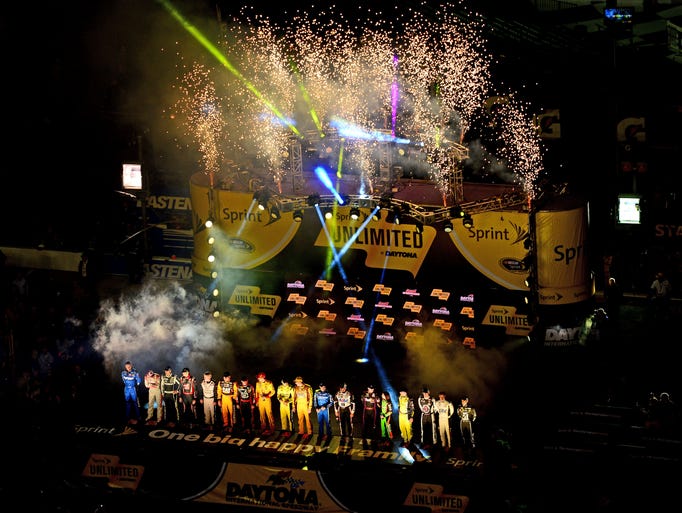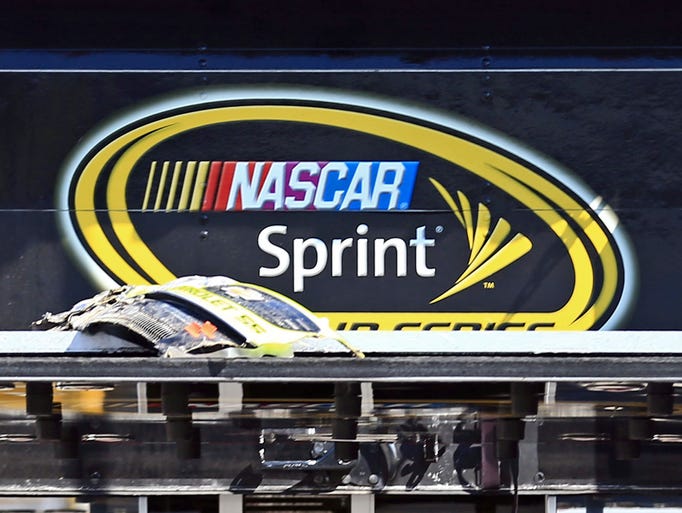Drivers, fans want NASCAR venue changes but tinkering complex – USA TODAY
As racing teams plan and plot through the middle months of the season, some NASCAR officials are designing far beyond autumn’s Chase for the Sprint Cup.
Over the next several weeks, sanctioning agreements will be signed with speedways across the continent with a goal of making 2016 schedules for NASCAR’s three national series — Sprint Cup, Xfinity and Camping World Truck — public earlier than last year’s late August release. A partial goal of the push is to give teams, tracks and those other omnipresent NASCAR “stakeholders” (mostly television networks) more time to plan.
When the schedules are unveiled, chances are they will be very similar to the 2015 versions, despite the fact that some drivers — and more than a few fans — say they would like to see the Sprint Cup schedule, in particular, include new venues. Some drivers also talk about shortening a schedule that has 36 points races and two special events and shortening the distances of some races.
Carl Edwards told USA TODAY Sports he echoed the sentiments shared by reigning Cup champion Kevin Harvick who said last month: “If you want to talk about growing the sport, I believe that some venues need one race. I believe that the schedule needs to be mixed up. People like things that change. They don’t like stagnant things. The most stagnant thing in our sport is our schedule and our venues that we go to.”
Edwards admitted he takes a selfish approach to such matters.
“I always want what’s best for the sport,” Edwards said. “I want the fans to enjoy it. I’m willing to go to some of these tracks that maybe aren’t my favorite tracks because people like them. But, for me, from the pure driving standpoint, I’d never go to a track twice.
“I’d go to tracks all over the country. I’d run Road America (in Elkhart Lake, Wis.) and go back to Pikes Peak (Colorado Springs, Colo). I’d run more short tracks. In a perfect dream world, you’d run new tracks every year. There would be a rotation of maybe five or six tracks that would change every year.”
The schedule-makers have a complex, difficult task. They strive to satisfy several publics – fans, team owners, track operators, drivers, television executives — as they grid races from February to November in a variety of environments. The NASCAR orbit includes big cities such as Chicago and Dallas-Fort Worth and relatively pastoral locations such as Martinsville, Va., and Newton, Iowa.
Where might Edwards’ rotating tracks be nestled?
“If you said the Cup series was going to Road America next year, there would be 200,000 people there,” Edwards said. “If you had a Cup race at Raceway Park (now Lucas Oil Raceway) in Indianapolis, it would be the biggest thing that ever happened. I went to the Xfinity race at Milwaukee, and it was like going to the state fair.”
Most tracks have had attendance challenges for much of the past deade, and television ratings generally have sagged as the sports competition market has expanded and some NASCAR races have been moved to second-tier channels — such as Fox Sports 1. As NBC returns to the sport this weekend at Daytona International Speedway, some Cup races will be broadcast on NBC Sports Network.
Schedule shuffle
The 2015 Cup schedule brought notable changes.
Darlington Raceway’s event was returned to its traditional Labor Day weekend date after being bounced between the spring and November. The Southern 500 was moved to November in 2004 and then to May from 2005-2013 before landing in April last season. Atlanta’s date was moved from the fall to the second race of the year, in March. Bristol’s “spring” race was moved from the fourth race of the year, also in March, to the eighth in pursuit of better weather. It didn’t work out so well, as it took nearly nine hours to complete a waterlogged event April 19.
NASCAR vice chairman Mike Helton, who said he doesn’t expect any significant shifts for 2016, said the sanctioning body is open to changes but he likes the idea of letting the new structure settle.
“We never pass up an opportunity, but we’re kind of locked in with the industry to give 2015 a chance to settle,” Helton told USA TODAY Sports. “We’ve always looked at schedules and formats and race distances and so forth. I couldn’t tell you of a major change that has a lot of legs under it right now, but there are a lot of models we’re looking at and talking about.”
NASCAR created what it called the West Coast swing by stringing races at Las Vegas, Phoenix and Fontana, Calif., changing an early-season schedule that previously ran Daytona-Phoenix-Las Vegas-Bristol-Fontana.
NASCAR plans to put a bigger foundation under the West Coast schedule next season by staging a January media event that would focus on that three-race group.
“I think there obviously were questions about Atlanta before we went in there,” Helton said. “It wasn’t the greatest day (weather was bad), but we got in and got out on the weekend. It worked very well for the fans, and we had one of the biggest TV audiences we’ve had for that weekend. So we now know that that weekend can work. And it teed us up for the West Coast swing, which the industry has said had a good feel to it.
“So, we’ll see. Those are the kinds of things you have to give some time to get fully felt out.”
TV ratings were mixed for the West Coast races under the new scheduling. Las Vegas saw an increase in viewers from 7.2 million in 2014 to 7.7 million, and Auto Club Speedway was up from 7.1 million to 7.3 million. However, Phoenix numbers plummeted from 8.8 million to 7.0 million.
PHOTOS: 2015 NASCAR Sprint Cup venues and schedule
Although most garage-area residents are careful with their words when discussing scheduling, in part so they won’t offend speedways with one or more races, there is general agreement among competitors that new venues would be welcome and that some of the tracks that currently host two Cup races should lose one. Dover, Pocono, Martinsville and New Hampshire sometimes come up in this context.
These are difficult waters to cross, of course. Speedways that have hosted two races for decades might struggle with only one date and the lost revenue. There also are questions of conflict. Would adding a Cup race at Iowa hurt ticket sales at nearby venues such as Chicagoland and Kansas?
In a difficult economic and competitive environment in which some tracks have seen ticket sales plummet, would it be reasonable to give new venues and potential new fan bases a chance?
As senior vice president of racing operations for NASCAR, Jim Cassidy is a point man in the process. He and his staff take input from a wide variety of sources while filling the calendar.
“We’re not going to please everybody, but we listen to everybody from the different cores of the sport,” Cassidy told USA TODAY Sports. “We want to know what they’re feeling, what they’re thinking and what their desires are. It’s a pretty delicate balance across the fan base and the promoter case. We find our way, but maybe not using the same path every year because of the different levels of input.”
Balancing act
Harvick suggested having a sort of lottery each year and picking a “wild card” track for the Cup series to visit. Such an approach, while unlikely, would include a lot of groundwork. Speedways hosting NASCAR events, particularly the Cup series, are expected to meet certain minimums in areas like track infrastructure, safety equipment and hotel room availability for teams and fans.
Travis Geisler, competition director for Team Penske, which fields cars for drivers Brad Keselowski and Joey Logano, said teams want the sort of schedule that will promote growth in attendance and TV ratings. Many tracks have been removing large sections of seating, including Daytona, Charlotte and Dover this year.
“I would be excited about hitting some other places, but I also know there are a lot of places that have been with us for a long time, and we have to respect what they’ve done for the sport, too,” Geisler told USA TODAY Sports. “It’s a big balancing act. There are a lot of variables and stakeholders involved. I appreciate NASCAR for being willing to talk to people and being open about what to do.
“The expectations of the fans and what’s out there for entertainment possibilities has gone up, and we have to adjust to that. We need to get better to keep up with the options that are out there for people.”
Pocono Raceway, which hosts Cup races in June and August, sometimes is mentioned as a sacrificial lamb when the idea of planting races at new venues is discussed. Track president Brandon Igdalsky, grandson of founder Joe Mattioli, has been aggressive in making improvements at Pocono in recent years and says talk of the track losing one of its dates has faded.
“I think we’ve turned the tide of how people look at us,” he told USA TODAY Sports. “I haven’t heard Pocono mentioned like that for a while, other than a few drivers or stragglers saying no tracks at all should have two races.”
Igdalsky points to two Pocono positives — the crowds for the track’s two races are vastly different, he said, and resort growth in the Pocono Mountains is adding to the track’s potential.
“We have only about 20 percent fan duplication at the two races,” he said. “Eighty percent of the August crowd will be different, mainly because kids are out of school and we get a lot more families. Also, if you look at the market, we’re only an hour and a half from Philadelphia and New York, and we’re within an easy drive of one-third of the United States population. There are so many people to draw from.”
The recently formed Drivers Council — which includes Harvick — is likely to have at least advisory input in future scheduling choices.
“I don’t think one person has the answer if it’s on the NASCAR side, driver side, team side, but I think we need to look at all options,” said six-time Cup champion Jimmie Johnson. “Trying to identify obviously with what is popular is the name of our game and trying to appeal to the masses and have (television) viewership.”
PHOTOS: Key moments in the 2015 NASCAR season










